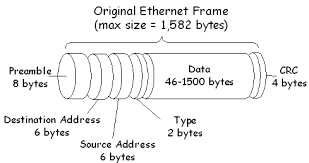In the intricate tapestry of network communication, a ‘network frame’ serves as a fundamental building block. This essential unit of data transmission operates at the heart of network interactions, specifically within the data-link layer and physical layer of the seven-layer OSI Model. A network frame is a packaged piece of data composed of various segments, including a header with a preamble, destination and source addresses, a data payload, and often error-checking information.
This article aims to unravel the complexities of network frames, offering a deep dive into their structure, function, and significance in the realm of networking. We’ll explore how frames are created, transmitted, and processed within a network, delving into each component’s role and the overarching mechanisms ensuring efficient and reliable data communication.
Table of Contents:
- What is a Network Frame?
- Understanding the Network Frame Structure
- Creation and Transmission of Frames
- Frames in the OSI Model
- Types of Network Frames
- Error Detection and Correction in Frames
- Advanced Concepts
- Conclusion
- References

1. What is a Network Frame?
A Network Frame is a segment of data on a network or telecommunications link, generally consisting of a header with preamble (start of frame flag), destination and source addresses, data payload, and usually some form of error-checking information. Frames are assembled and generated by the data-link layer and physical layer of the seven-layer OSI Model.
This assembly process is called “framing.” In other words, packets from the network layer are encapsulated by the data-link layer into frames. Data segments generated by higher layers of the OSI model are generally referred to as packets, but the term “packet” is also sometimes used to include frames.
The format in which data frames are constructed depends on the particular data-link layer protocol being used. Thus, we can speak of Ethernet frames, Integrated Services Digital Network (ISDN) frames, X.25 frames, frame relay frames, and so on. Each particular local area network (LAN) or wide area network (WAN) data-link protocol has its own method of framing data for transmission over the network or telecommunications line. Frames can be fixed-length or variable-length, and have addressing information for multipoint connections or no addressing information for point-to-point connections. They can also have error correction, as in X.25, or no error correction, as in frame relay.
2. Understanding the Network Frame Structure
Detailed Examination of Each Component of a Network Frame
A network frame is a structured packet of data essential for effective network communication. Each component of a frame has a specific role, working in harmony to ensure the accurate and efficient transmission of data.
- Preamble: The preamble is the beginning of the frame, consisting of a sequence of bits that alerts receiving devices to the arrival of a frame and enables synchronization.
- Header: Following the preamble, the header contains critical control information. It typically includes the source and destination MAC (Media Access Control) addresses, identifying the sender and receiver within the network.
- Type/Length Field: This part of the header indicates either the type of protocol being used in the payload or the length of the frame.
- Data Payload: The core of the frame, the payload, carries the actual data being transmitted. Its size can vary, but it’s typically constrained by the network’s maximum transmission unit (MTU).
- Error-Checking Information: Often in the form of a frame check sequence (FCS), this part is crucial for error detection. It allows the receiver to determine if the frame arrived intact or if it encountered transmission errors.

Role of the Header, Preamble, Addresses, Payload, and Error-Checking
- Header: Sets the frame’s context and provides routing information.
- Preamble: Ensures the receiver is ready and synchronized for the frame.
- Addresses: Identify the communicating devices within the network.
- Payload: Transports the user or application data.
- Error-Checking: Maintains data integrity by detecting transmission errors.
3. Creation and Transmission of Frames
How Frames are Assembled in the Data-Link Layer
Frame assembly occurs in the data-link layer, the second layer of the OSI Model. This layer is responsible for the logical structuring of data packets into frames. The process starts with raw data from the network layer, which is then encapsulated with the necessary headers and trailers. This encapsulation includes the addition of source and destination addresses, type/length information, and the FCS for error-checking.
The Process of Transmitting Frames Through the Physical Layer
Once a frame is assembled, it is passed down to the physical layer, where it is converted into signals for transmission over the network medium. The physical layer handles the encoding and signaling, ensuring that the data in the frame is transmitted in a format that is understandable by the receiving hardware. Depending on the network type (like Ethernet, Wi-Fi, or fiber optics), the physical layer’s role includes defining connectors, voltage levels, and other physical specifications. The frame travels through the network medium, reaching its destination, where it is received and processed by the physical layer and then passed up to the data-link layer for further processing.
4. Frames in the OSI Model
Exploration of How Network Frames Fit into the OSI Model
The OSI (Open Systems Interconnection) Model, a conceptual framework used to understand network interactions, categorizes network processes into seven distinct layers. Network frames specifically operate within the Data-Link Layer (Layer 2) but are influenced by, and interact with, other layers in the model.
- Layer 2: Data-Link Layer: This layer is where frames are primarily managed. It’s responsible for node-to-node data transfer, error detection in frames, and flow control. The Data-Link Layer ensures that the physical transmission of data is reliable and error-free.
- Layer 1: Physical Layer: Frames, as structured packets, are converted into electrical, radio, or light signals in the Physical Layer for transmission over the network medium.
- Layer 3: Network Layer: The Network Layer deals with network addressing and routing. While it primarily uses packets, the information it adds (like IP addresses) is encapsulated within the frame at the Data-Link Layer.
Interaction Between the Data-Link Layer and Other Layers in the Model
The Data-Link Layer’s role in framing complements the functions of the adjacent layers:
- To/From the Physical Layer: It translates the logical network layout into physical hardware connections and vice versa.
- To/From the Network Layer: It encapsulates the Network Layer’s packets within frames, adding MAC addresses and error-checking elements, crucial for delivering data to the correct network destination.
5. Types of Network Frames
Different Types of Frames
Network frames vary depending on the network type and protocol. Some common types include:
- Ethernet Frame: The most widely used frame type in LANs. It includes a preamble, source and destination MAC addresses, an optional VLAN tag, the payload, and a Frame Check Sequence (FCS) for error detection.
- Token Ring Frame: Used in Token Ring networks, these frames circulate around the network, with an empty frame being filled with data by a device when it needs to transmit. They contain a similar structure to Ethernet frames but include a token bit for network traffic control.
- ATM Frame: Used in Asynchronous Transfer Mode (ATM) networks, these frames, or cells, are of fixed size, simplifying processing and enabling fast data transfer rates, ideal for voice and video traffic.
Characteristics and Specific Uses of Each Type
- Ethernet Frame: Known for its simplicity and efficiency, Ethernet frames are used for both wired and wireless LANs. They support a variety of protocols and are ideal for most modern networking needs.
- Token Ring Frame: Token Ring frames offer a methodical approach to network access, reducing collisions in network traffic. However, they are less common in modern networks due to the popularity of Ethernet.
- ATM Frame: These frames excel in environments requiring consistent data transmission rates, such as multimedia streaming. They provide predictable network performance but are more complex and costly compared to Ethernet.
6. Error Detection and Correction in Frames
Mechanisms for Error-Checking in Network Frames
Error-checking is a critical component in network frames to ensure data integrity. Several mechanisms are employed to detect and correct errors that may occur during transmission:
- Frame Check Sequence (FCS): The most common method used in network frames, typically at the end of the frame. It’s a type of checksum, calculated based on the frame’s contents. Receivers recompute the checksum and compare it with the FCS to detect errors.
- Cyclic Redundancy Check (CRC): A robust version of checksum used in Ethernet frames. CRC algorithms are designed to detect alterations caused by noise or other impairments during transmission.
- Parity Checks: Some network systems use parity bits, either even or odd, as a simple form of error detection. While not as thorough as FCS or CRC, parity checks can detect single-bit errors.
Techniques Used for Error Detection and Correction
- Automatic Repeat Request (ARQ): This technique involves retransmitting data frames whenever an error is detected. It includes schemes like Stop-and-Wait ARQ, Go-Back-N ARQ, and Selective Repeat ARQ, each varying in efficiency and complexity.
- Forward Error Correction (FEC): In this method, the sender includes additional error-correcting code in the frame. FEC allows the receiver to detect and correct errors without the need for retransmission, useful in real-time applications.
7. Advanced Concepts
Frame Sequencing and Control
Effective frame management in networks involves more than just sending and receiving data; it requires precise control and sequencing.
- Sequence Numbers: These are used to keep track of the order of frames, especially in protocols that allow for multiple frames to be sent before receiving an acknowledgment. Sequence numbers help in reordering frames that may arrive out of sequence.
- Flow Control: This involves managing the rate at which frames are sent to prevent overwhelming a receiver or congesting the network. Techniques like windowing in TCP control the flow of frames between sender and receiver.
Frame Prioritization and Quality of Service (QoS)
In complex network environments, managing the priority of frames is essential to maintain QoS:
- Priority Queuing: Frames can be prioritized based on type, with critical data being transmitted first. This is particularly important in networks carrying mixed traffic, like voice, video, and data.
- QoS Markings: Frames can be marked with specific QoS indicators, guiding network devices on how to treat different types of traffic, ensuring that high-priority traffic like voice and video is given precedence over less critical data.
8. Conclusion
In conclusion, network frames are the backbone of data communication in networking. From their structured composition to their role in error detection and correction, frames ensure that data is transmitted efficiently and accurately across networks. The exploration of frame structures, types, and their functions within the OSI Model underscores their significance in network communications.
Advanced concepts like frame sequencing, control, and Quality of Service (QoS) highlight the sophistication involved in managing network traffic. As technology evolves, the principles governing network frames continue to be crucial for the development of reliable and efficient networking systems. Understanding these fundamental aspects is essential for anyone looking to deepen their knowledge in the field of network communications.
9. References
- “Computer Networks” by Andrew S. Tanenbaum and David J. Wetherall.
- “Data Communications and Networking” by Behrouz A. Forouzan.
- RFC 1180: A TCP/IP Tutorial from the Internet Engineering Task Force (IETF).
- “Networking Essentials” by Jeffrey S. Beasley and Piyasat Nilkaew.
- “TCP/IP Guide: A Comprehensive, Illustrated Internet Protocols Reference” by Charles M. Kozierok.